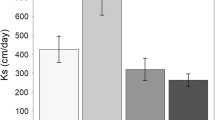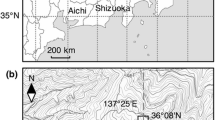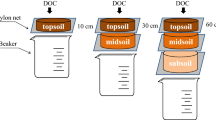Abstract
About 0.3 million km2 of boreal forests and peatlands and their soils have been flooded through the creation of hydroelectric reservoirs. To establish the effect of flooding on dissolved organic carbon (DOC) and total dissolved nitrogen (TDN) production, we incubated six sample types of boreal forest and peatland soils and litters for 15 weeks under flooded (anoxic and suboxic) and non-flooded (oxic) conditions at three temperatures (4, 12, and 22 °C). Water was sampled at 3-week intervals and analyzed for DOC and TDN concentration. Cumulative DOC and TDN production ranged widely: from 4.4 to 146.2 mg C g−1 C for DOC and 4.4 to 112.2 mg N g−1 N for TDN under flooded conditions, and from 1.3 to 16.6 mg C g−1 C for DOC and 0.7 to 8.5 mg N g−1 N for TDN under non-flooded conditions. Cumulative DOC and TDN production was greater under flooded than non-flooded conditions for all sample types with flooded:non-flooded ratios averaging 10.6 for DOC and 9.5 for TDN. Within the flooded treatments, anoxic conditions produced more cumulative DOC and TDN than suboxic conditions, with average anoxic:suboxic ratios of 1.3 and 5.8 for DOC and TDN, respectively. Raising temperatures increased cumulative DOC and TDN production marginally under both flooded and non-flooded conditions as the average ratios for 22:12 and 12:4 °C were 1.1 for DOC and 1.2 for TDN. Generally, more DOC and TDN were released from litters than soils under both the flooded and non-flooded incubations, with litter:soil ratios averaging 8.5 for DOC and 2.1 for TDN. DOC:TDN ratio was generally higher in the solutions than in the original sample, particularly in the litters. This study thus indicated that DOC and TDN production was largely affected by flooding regime, O2 concentration, and substrate characteristics and less affected by temperature.




Similar content being viewed by others
References
Abril G, Guérin F, Richard S, Delmas R, Galy-Lacaux C, Gosse P, Tremblay A, Varfalvy L, dos Santos MA, Matvienko B (2005) Carbon dioxide and methane emissions and the carbon budget of a 10-year old tropical reservoir (Petit Saut, French Guiana). Global Biogeochem Cycles 19:GB4007. doi:4010.1029/2005GB002457
Aguilar L, Thibodeaux LJ (2005) Kinetics of peat soil dissolved organic carbon release from bed sediment to water. Part 1. Laboratory simulation. Chemosphere 58:1309–1318
Andersson S, Nilsson SI, Saetre P (2000) Leaching of dissolved organic carbon (DOC) and dissolved organic nitrogen (DON) in mor humus as affected by temperature and pH. Soil Biol Biochem 32:1–10
Barros N, Cole JJ, Tranvik LJ, Prairie YT, Bastviken D, Huszar VLM, del Giorgio P, Roland F (2011) Carbon emission from hydroelectric reservoirs linked to reservoir age and latitude. Nat Geosci 4:593–596
Bengtson P, Bengtsson G (2007) Rapid turnover of DOC in temperate forests accounts for increased CO2 production at elevated temperatures. Ecol Lett 10:783–790
Blodau C, Moore TR (2003) Experimental response of peatland carbon dynamics to a water table fluctuation. Aquat Sci 65:47–62
Bodaly BA, Beaty KG, Hendzel LH, Majewski AR, Paterson MJ, Rolfhus KR, Penn AF, St.Louis VL, Hall BD, Matthews CJD, Cherewyk KA, Mailman M, Hurley JP, Schiff SL, Venkiteswaran JJ (2004) Experimenting with hydroelectric reservoirs. Environ Sci Technol 38:347A–352A
Brenner RE, Boone RD, Jones JB Jr, Lajtha K, Ruess RW (2006) Successional and physical controls on the retention of nitrogen in an undisturbed boreal forest ecosystem. Oecologia 148:602–611
Chow AT, Guo F, Gao S, Breuer R, Dahlgren RA (2005) Filter pore size selection for characterizing dissolved organic carbon and trihalomethane precursors from soils. Water Res 39:1255–1264
Chow AT, Tanji KK, Gao S, Dahlgren RA (2006) Temperature, water content and wet–dry cycle effects on DOC production and carbon mineralization in agricultural peat soils. Soil Biol Biochem 38:477–488
Currie WS, Aber JD (1997) Modeling leaching as a decomposition process in humid montane forests. Ecology 78:1844–1860
Day FP (1983) Effects of flooding on leaf litter decomposition in microcosms. Oecologia 56:180–184
Don A, Kalbitz K (2005) Amounts and degradability of dissolved organic carbon from foliar litter at different decomposition stages. Soil Biol Biochem 37:2171–2179
Gagnon L, van de Vate JF (1997) Greenhouse gas emissions from hydropower: the state of research in 1996. Energy Policy 25:7–13
Kelly CA, Rudd JWM, Bodaly RA, Roulet NT, St.Louis VL, Heyes A, Moore TR, Schiff S, Aravena R, Scott KJ, Dyck B, Harris R, Warner B, Edwards G (1997) Increases in fluxes of greenhouse gases and methyl mercury following flooding of an experimental reservoir. Environ Sci Technol 31:1334–1344
Kim Y, Ullah S, Roulet NT, Moore TR (under review) The effect of inundation, oxygen level, and temperature on carbon mineralization in boreal forest and peatland soils and litter. J Environ Qual
Kristensen E, Holmer M (2001) Decomposition of plant materials in marine sediment exposed to different electron acceptors (O2, NO3 −, and SO4 2−), with emphasis on substrate origin, degradation kinetics, and the role of bioturbation. Geochim Cosmochim Acta 65:419–433
Lemieux M-E (2010) From forest to lake: effect of hydroelectric reservoir impoundment on the net ecosystem exchange of CO2. MSc thesis, McGill University
Lockaby BG, Murphy AL, Somers GL (1996) Hydroperiod influences on nutrient dynamics in decomposing litter of a floodplain forest. Soil Sci Soc Am J 60:1267–1272
Magill AH, Aber JD (2000) Dissolved organic carbon and nitrogen relationships in forest litter as affected by nitrogen deposition. Soil Bio Biochem 32:603–613
Matthews CJD, Joyce EM, St. Louis VL, Schiff SL, Venkiteswaran JJ, Hall BD, Bodaly RA, Beaty KG (2005) Carbon dioxide and methane production in small reservoirs flooding upland boreal forest. Ecosystems 8:267–285
McArthur MD, Richardson JS (2002) Microbial utilization of dissolved organic carbon leached from riparian litterfall. Can J Fish Aquat Sci 59:1668–1676
McDowell WH, Likens GE (1988) Origin, composition, and flux of dissolved organic carbon in the Hubbard Brook Valley. Ecol Monogr 58:177–195
Megonigal JP, Hines ME, Visscher PT (2004) Anaerobic metabolism: linkages to trace gases and aerobic processes. In: Schlesinger WH (ed) Biogeochemistry. Elsevier, Pergamon
Michalzik B, Kalbitz K, Park J-H, Solinger S, Matzner E (2001) Fluxes and concentrations of dissolved organic carbon and nitrogen—a synthesis for temperate forests. Biogeochemistry 52:173–205
Moore TR, Dalva M (2001) Some controls on the release of dissolved organic carbon by plant tissues and soils. Soil Sci 166:38–47
Moore TR, Matos L, Roulet NT (2003) Dynamics and chemistry of dissolved organic carbon in Precambrian Shield catchments and an impounded wetland. Can J Fish Aquat Sci 60:612–623
Moore TR, Paré D, Boutin R (2008) Production of dissolved organic carbon in Canadian forest soils. Ecosystems 11:740–751
Neff JC, Hooper DU (2002) Vegetation and climate controls on potential CO2, DOC and DON production in northern latitude soils. Glob Change Biol 8:872–884
Paterson MJ, Findlay D, Beaty K, Findlay W, Schindler EU, Stainton M, McCullough G (1997) Changes in the planktonic food web of a new experimental reservoir. Can J Fish Aquat Sci 54:1088–1102
Pelletier L, Garneau M, Moore TR (2011) Variation in CO2 exchange over three summers at microform scale in a boreal bog, Eastmain region, Québec, Canada. J Geophys Res 116:G03019. doi:03010.01029/02011JG001657
Persson T, Lundkvist H, Wirén A, Hyvönen R, Wessén B (1989) Effect of acidification and liming on carbon and nitrogen mineralization and soil organisms in mor humus. Water Air Soil Pollut 45:77–96
Roehm CL, Prairie YT, del Giorgio PA (2009) The pCO2 dynamics in lakes in the boreal region of northern Québec, Canada. Global Biogeochem Cycle 23:GB3013. doi:3010.1029/2008GB003297
Schwesig D, Kalbitz K, Matzner E (2003) Mineralization of dissolved organic carbon in mineral soil solution of two forest soils. J Plant Nutr Soil Sci 166:585–593
Sjöberg G, Bergkvist B, Berggren D, Nilsson SI (2003) Long-term N addition effects on the C mineralization and DOC production in mor humus under spruce. Soil Biol Biochem 35:1305–1315
Smolander A, Kitunen V (2002) Soil microbial activities and characteristics of dissolved organic C and N in relation to tree species. Soil Biol Biochem 34:651–660
Solinger S, Kalbitz K, Matzner E (2001) Controls on the dynamics of dissolved organic carbon and nitrogen in a Central European deciduous forest. Biogeochemistry 55:327–349
St. Louis VL, Kelly CA, Duchemin E, Rudd JWM, Rosenberg DM (2000) Reservoir surfaces as sources of greenhouse gases to the atmosphere: a global estimate. Bioscience 50:766–775
Strauss EA, Lamberti GA (2002) Effect of dissolved organic carbon quality on microbial decomposition and nitrification rates in stream sediments. Freshw Biol 47:65–74
Teodoru CR, Prairie YT, del Giorgio PA (2011) Spatial heterogeneity of surface CO2 fluxes in a newly created Eastmain-1 reservoir in northern Quebec, Canada. Ecosystems 14:28–46
Ullah S, Zinati GM (2006) Denitrification and nitrous oxide emissions from riparian forests soils exposed to prolonged nitrogen runoff. Biogeochemistry 81:253–267
Ullah S, Frasier R, Pelletier L, Moore TR (2009) Greenhouse gas fluxes from boreal forest soils during the snow-free period in Quebec, Canada. Can J For Res 39:666–680
Unger IM, Motavalli PP, Muzika R-M (2009) Changes in soil chemical properties with flooding: a field laboratory approach. Agric Ecosyst Environ 131:105–110
van Bellen S, Dallaire P-L, Garneau M, Bergeron Y (2011) Quantifying spatial and temporal Holocene carbon accumulation in ombrotrophic peatlands of the Eastmain region, Quebec, Canada. Global Biogeochem Cycle 25:2016. doi:2010.1029/2010GB003877
Wickland KP, Neff JC, Aiken GR (2007) Dissolved organic carbon in Alaskan boreal forest: sources, chemical characteristics, and biodegradability. Ecosystems 10:1023–1340
Acknowledgments
This study was funded by the Canadian Foundation for Climate and Atmospheric Research (CFCAS), the Natural Sciences and Engineering Research Council and Hydro-Québec. We thank Dr. Alain Tremblay (Hydro-Québec Production) who provided logistic support in the field trips, and Hélène Lesage, Mike Dalva, and Mark Romer (McGill University) for their help with experimental studies.
Author information
Authors and Affiliations
Corresponding author
Additional information
Responsible Editor: Chris D. Evans
Rights and permissions
About this article
Cite this article
Kim, Y., Ullah, S., Moore, T.R. et al. Dissolved organic carbon and total dissolved nitrogen production by boreal soils and litter: the role of flooding, oxygen concentration, and temperature. Biogeochemistry 118, 35–48 (2014). https://doi.org/10.1007/s10533-013-9903-8
Received:
Accepted:
Published:
Issue Date:
DOI: https://doi.org/10.1007/s10533-013-9903-8




